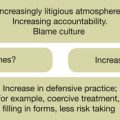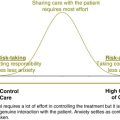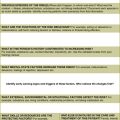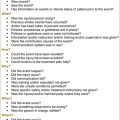Chapter 2 What is risk?
It must be understood that risk cannot be eliminated entirely. To do so would be to move from risk management to certainty management, which is not possible within clinical practice.1
For risks such as crossing the road or driving a car along the motorway, there is no need to think about how to manage the situation effectively as it has been done a thousand times before. Managing risk in a mental health setting is no different. It is primarily an exercise in decision-making. The task is to try and prevent adverse outcomes whilst maximising the likelihood of a good outcome (risks versus benefits). The process of decision-making can vary from an intuitive decision made on the run using cognitive shortcuts (heuristics; see glossary) to a deliberate, carefully considered plan made over several days or even weeks. There are advantages and disadvantages to each process which will be explored throughout the book. With regular practice, clinicians can learn to manage risky situations effectively and minimise the risk of adverse outcomes whilst continuing to treat and care for patients.
With the increasing accountability expected today, it has become more necessary to ‘document our thinking for the record’.2 Having a good structure simplifies this process substantially.
BOX 2.1 SUMMARY OF LEARNING POINTS
• If there were no potential benefits, clinicians would not need to take risks.
• Decision-making can be done quickly using cognitive shortcuts (heuristics) or be made more slowly in a deliberate and carefully weighed fashion.
• Having a clear structure to the assessment and management of risk makes practice transparent and improves communication.
Definition of risk
Dictionary definitions of risk vary, but commonly used definitions in mental health settings are:
What are the sorts of risks?
violence, death, litigation, complaints, coronial inquiries, verbal abuse, patients getting worse, burn out, sick leave, risk of relapse, insufficient resources, taking short cuts, side effects, needle stick injuries, overdose, medical complications, medication errors, social stigma, institutionalisation, stalking, intoxication, boundary problems, suicide, self-harm, and so on.
A simple method of categorising risk is set out in Table 2.1.
| Risks to self | Risk to others | Risk from others |
|---|---|---|
Risks to whom?
Clinicians may be at risk of burnout, stress, complaints or boundary violations.
What means might be used?
For violence, the history will need to include an exploration of whether the patient has a history of using weapons or whether the patient has access to weapons. For suicide, the clinical history always includes an exploration of the means that the patient has been thinking of using to complete the suicidal act.
Safety
1. ‘The patient couldn’t guarantee their safety so I admitted them.’
Nobody can guarantee their safety, never mind a patient with mental illness. This phrase is used less frequently nowadays but when it is used, it is unlikely that an adequate risk assessment will have been completed.
2. ‘The first thing I would like to consider in the management of this patient is the safety issue.’
When clinicians engage in ‘safety contracts’ with patients, they enter into a dynamic in which an offer is made to rescue them from their torment and take responsibility. A patient who agrees to a safety contract one day may have a differing mental state the next day and no longer agree to it, but the clinician will assume the agreement is still there.3 ‘Safety contracts’ were used extensively a decade ago, but fortunately have now become rare.
Eliciting guarantees of safety from the patient or developing ‘no self-harm contracts’ are not sufficient as sole management strategies and are not recommended.4, 5
BOX 2.2 WHAT IS RISK?
• Risk is the likelihood of an adverse outcome.
• The likelihood of risk changes over time.
• Risk is a part of every decision-making process of patient care.
• Risk involves not just the patient but the patient’s family, the community, mental health staff and the mental health service.
• The use of the word ‘safety’ is not recommended in risk management.
1 Royal College of Psychiatrists 2008 Rethinking Risk to Others in Mental Health Services. Final report of a scoping group. Royal College of Psychiatrists College Report CR 150, June.
2 Gutheil T.G. Paranoia and progress notes: a guide to forensically informed psychiatric record keeping. Hospital and Community Psychiatry. 1980;31(7):479–482.
3 Bateman A., Fonagy P. Mentalization Based Treatment for Borderline Personality Disorder. Oxford: Oxford University Press; 2006. p 48
4 Boyce P., et al. Summary of Australian and New Zealand clinical practice guidelines for the management of adult deliberate self-harm. Australasian Psychiatry. 2003;11(2):150–155.
5 Rudd M.D., Mandrusiak M., Joiner T. The case against No-Suicide Contracts: The commitment to treatment statements as a practice alternative. Journal of Clinical Psychology: In Session. 2007;62:243–251.






